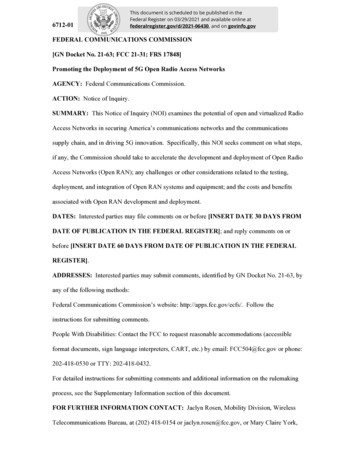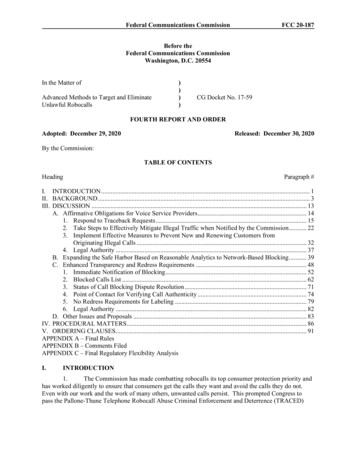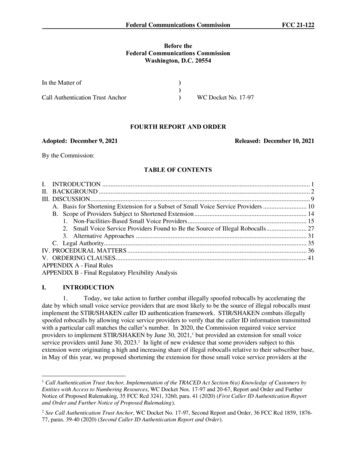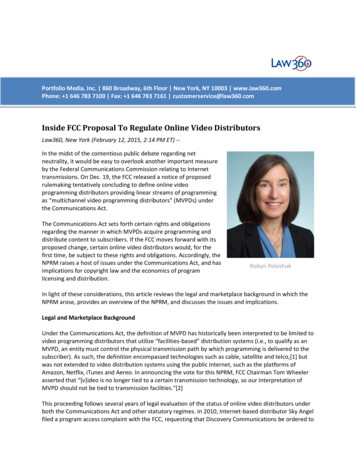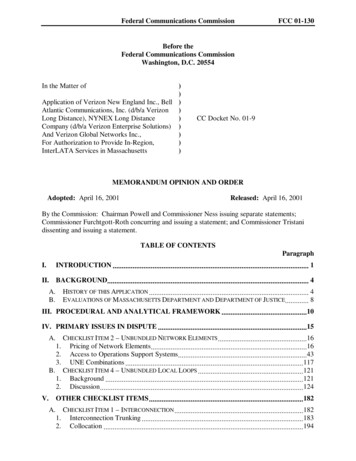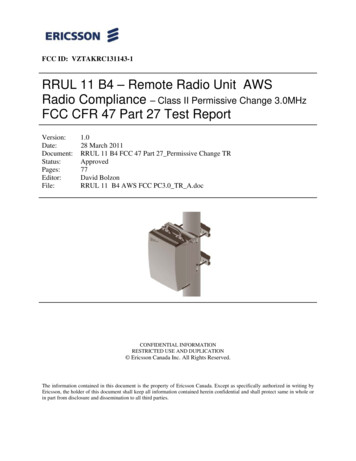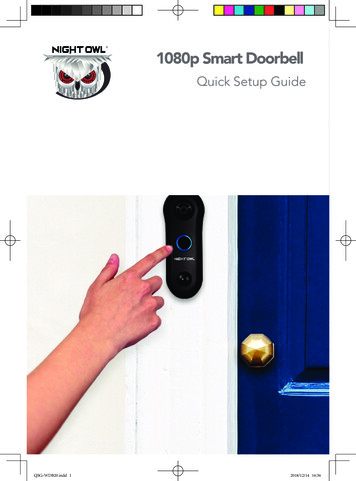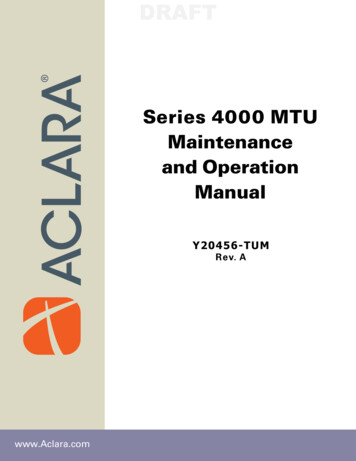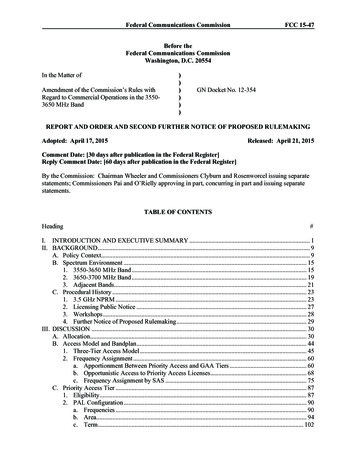
Transcription
Federal Communications CommissionFCC 15-47Before theFederal Communications CommissionWashington, D.C. 20554In the Matter ofAmendment of the Commission’s Rules withRegard to Commercial Operations in the 35503650 MHz Band))))))GN Docket No. 12-354REPORT AND ORDER AND SECOND FURTHER NOTICE OF PROPOSED RULEMAKINGAdopted: April 17, 2015Released: April 21, 2015Comment Date: [30 days after publication in the Federal Register]Reply Comment Date: [60 days after publication in the Federal Register]By the Commission: Chairman Wheeler and Commissioners Clyburn and Rosenworcel issuing separatestatements; Commissioners Pai and O’Rielly approving in part, concurring in part and issuing separatestatements.TABLE OF CONTENTSHeading#I. INTRODUCTION AND EXECUTIVE SUMMARY . 1II. BACKGROUND. 9A. Policy Context. 9B. Spectrum Environment . 151. 3550-3650 MHz Band . 152. 3650-3700 MHz Band . 193. Adjacent Bands. 21C. Procedural History . 231. 3.5 GHz NPRM . 232. Licensing Public Notice . 273. Workshops. 284. Further Notice of Proposed Rulemaking. 29III. DISCUSSION . 30A. Allocation. 30B. Access Model and Bandplan. 441. Three-Tier Access Model. 452. Frequency Assignment . 60a. Apportionment Between Priority Access and GAA Tiers . 60b. Opportunistic Access to Priority Access Licenses. 68c. Frequency Assignment by SAS . 75C. Priority Access Tier . 871. Eligibility. 872. PAL Configuration . 90a. Frequencies . 90b. Area. 94c. Term. 102
Federal Communications CommissionFCC 15-473. Spectrum Aggregation Limits . 1144. Competitive Bidding Procedures. 122a. PAL Applications Subject to Competitive Bidding. 125b. Application of Part 1 Competitive Bidding Rules . 142c. Bidding Process Options. 147D. General Authorized Access. 1551. Authorization Methodology . 1562. Contained Access Facilities. 164E. Regulatory Status. 170F. Technical Rules. 1741. General Radio Requirements. 175a. Digital Modulation. 175b. Emissions and Interference Limits. 176c. Received Signal Strength Limits. . 1912. CBSD Requirements . 198a. CBSD Categories and power requirements. . 198b. Geo-location and Reporting capability. . 215c. Band-wide operability. 223d. Registration Requirements. 230e. Interference Reporting. . 235f. Security. . 2383. End User Device Requirements . 2414. Other Technical Issues . 246G. Incumbent Protections . 2471. Federal Incumbent Protection . 247a. Multi-Phase Approach . 247b. Protection of CBSDs from Radar Interference . 2692. Protection of Incumbent FSS Earth Stations . 276a. FSS Earth Stations in the 3.5 GHz Band . 276b. Out-of-Band FSS Protection . 2923. Operations near International Borders. 297H. Spectrum Access System . 3011. General SAS Functions . 3022. High Level SAS Requirements . 316a. Information Gathering and Retention . 322b. Registration, Authentication, and Authorization of CBSDs . 331c. Frequency Assignment . 334d. Security . 342e. Enforcement. 3493. SAS Administrators. 353a. SAS Administrator Requirements. 356b. SAS and SAS Administrator Approval Process . 367c. SAS Administrator Fees . 374I. Environmental Sensor Capability . 379J. 3650-3700 MHz Band. 387K. Multi-Stakeholder Group . 413IV. SECOND FURTHER NOTICE OF PROPOSED RULEMAKING . 415A. Defining “Use” of PAL Frequencies . 419B. Implementing Secondary Markets in Priority Access Licenses. 431C. Optimizing Protections for FSS . 4361. In-band protection of FSS in 3650-3700 MHz. 4362. Out-of-band protection of C-Band FSS. 4432
Federal Communications CommissionFCC 15-47V. PROCEDURAL MATTERS. 446A. Ex Parte Presentations . 446B. Comment Filing Procedures . 448C. Regulatory Flexibility Analysis . 449D. Paperwork Reduction Act . 450E. Congressional Review Act. 452VI. ORDERING CLAUSES. 453APPENDIX A – Final RulesAPPENDIX B – Final Regulatory Flexibility AnalysisAPPENDIX C – Initial Regulatory Flexibility AnalysisAPPENDIX D – List of CommentersI.INTRODUCTION AND EXECUTIVE SUMMARY1.With this Report and Order (Report and Order or R&O), we adopt rules for commercialuse of 150 megahertz in the 3550-3700 MHz band (3.5 GHz Band), and in so doing open a new chapter inthe history of the administration of one of our nation’s most precious resources—the electromagneticradio spectrum. 1 Wireless broadband is transforming every facet of American life. We live in a world ofwirelessly connected people, apps, and things. The 3.5 GHz Band has physical characteristics that makeit particularly well-suited for mobile broadband employing small cell technology. The creation of ournew Citizens Broadband Radio Service in this band will therefore add much-needed capacity to meet theever-increasing demands of wireless innovation. As such, it represents a major contribution toward ourcollective goal of making 500 megahertz newly available for broadband use.2.Advances in radio and computing technologies provide new tools to facilitate moreintensive spectrum sharing. Our new rules use these tools to dissolve some age-old regulatory divisions,between commercial and federal users, exclusive and non-exclusive authorizations, and private andcarrier networks. Starting from some of the recommendations of the President’s Council of Advisors onScience and Technology (PCAST), these rules incorporate a wide range of viewpoints and informationcollected through three rounds of notice and comment. Over time, some of the approaches we advance inthe 3.5 GHz “innovation band” could lead to greater productivity in other parts of the radio spectrum.3.The R&O establishes a roadmap for making the entirety of the 3.5 GHz Band available forcommercial use in phases. The 3550-3650 MHz band segment is currently allocated for use byDepartment of Defense (DoD) radar systems. The National Telecommunications and InformationAdministration (NTIA) first proposed making the band available for shared use in its 2010 “Fast TrackReport.” Based on technical assumptions available at the time, NTIA’s analysis showed that largeexclusion zones would be required to protect the DoD radar systems. Last year’s Further Notice ofProposed Rulemaking (FNPRM or 3.5 GHz FNPRM) sought comment on the Fast Track exclusion zones,but mentioned ongoing discussions among federal agencies on ways to reevaluate the zones.2 On March24, 2015, NTIA filed a letter recommending a framework that would reduce the geographic area of thezones by approximately 77 percent.3 NTIA’s letter also recommended the use of sensor technology to1We note that the term 3.5 GHz Band was used to refer to the 3550-3650 MHz band in earlier phases of thisproceeding. Since we have determined to include the 3650-3700 MHz band in the Citizens Broadband RadioService, “3.5 GHz Band” refers to the entire 3550-3700 MHz for purposes of this Report and Order. Where rulesapply to only a portion of the band (i.e., 3650-3700 MHz), we address those band segments specifically.2Amendment of the Commission’s Rules with Regard to Commercial Operations in the 3550-3650 MHz Band, GNDocket No. 12-354, FCC 14-49, Further Notice of Proposed Rulemaking, 29 FCC Rcd 4273, 4316 ¶ 141 (3.5 GHzFNPRM).3See Letter from Paige R. Atkins, Associate Administrator, Office of Spectrum Management, NTIA to Julius P.Knapp, Chief, Office of Engineering and Technology, FCC in GN Docket No. 12-354 (filed March 24, 2015) (NTIALetter).3
Federal Communications CommissionFCC 15-47permit commercial use inside the zones, providing a roadmap to full nationwide commercial use of theband.4.This federal/non-federal sharing arrangement is part of a broader three-tiered sharingframework enabled by a Spectrum Access System (SAS).4 Incumbent users represent the highest tier inthis framework and receive interference protection from Citizens Broadband Radio Service users.Protected incumbents include the federal operations described above, as well as Fixed Satellite Service(FSS) and, for a finite period, grandfathered terrestrial wireless operations in the 3650-3700 MHz portionof the band. The Citizens Broadband Radio Service itself consists of two tiers—Priority Access andGeneral Authorized Access (GAA)—both authorized in any given location and frequency by an SAS. Asthe name suggests, Priority Access operations receive protection from GAA operations. Priority AccessLicenses (PALs), defined as an authorization to use a 10 megahertz channel in a single census tract forthree years, will be assigned in up to 70 megahertz of the 3550-3650 MHz portion of the band. GAA usewill be allowed, by rule, throughout the 150 megahertz band. GAA users will receive no interferenceprotection from other Citizens Broadband Radio Service users.5.Our new rules advance a potential solution to a long-standing problem in spectrum policy:how to select the most appropriate commercial authorization or licensing mechanism for a new band. Therecord has brought us back to first principles. We have considered ideas from three major traditions inspectrum management: flexible-use geographic licensing, site-based frequency coordination, andunlicensed authorization. Ultimately, we adopt a hybrid framework that selects, automatically, the bestapproach based on local supply and demand. Where competitive rivalry for spectrum access is low, theGAA tier provides a low-cost entry point to the band, similar to unlicensed access. Where rivalry is high,an auction resolves mutually exclusive applications in specific geographic areas for PALs. Finite-termlicensing facilitates evolution of the band and an ever-changing mix of GAA and Priority Accessbandwidth over time. The SAS serves as an advanced, highly automated frequency coordinator across theband. It protects higher tier users from those beneath and optimizes frequency use to allow maximumcapacity and coexistence for both GAA and Priority Access users.6.This regulatory adaptability should make the 3.5 GHz Band hospitable to a wide varietyof users, deployment models, and business cases, including some solutions to market needs notadequately served by our conventional licensed or unlicensed rules. Carriers can avail themselves of“success-based” license acquisition, deploying small cells on a GAA basis where they need additionalcapacity and paying for the surety of license protection only in targeted locations where they find ademonstrable need for more interference protection. Real estate owners can deploy neutral host systemsin high-traffic venues, allowing for cost-effective network sharing among multiple wireless providers andtheir customers. Manufacturers, utilities, and other large industries can construct private wirelessbroadband networks to automate processes that require some measure of interference protection and yetare not appropriately outsourced to a commercial cellular network. Smart grid, rural broadband, small cellbackhaul, and other point-to-multipoint networks can potentially access three times more bandwidth thanwas available under our previous 3650-3700 MHz band rules. All of these applications could sharecommon wireless technologies, providing economies of scale and facilitating intensive use of thespectrum.7.In specifying rules for the SAS—the lynchpin of the Citizens Broadband Radio Service—we balance a need for clear definition of its role, purposes, and functions against a desire to allow marketforces and industry standards to inform the specifics of implementation. We will open a process by whichmultiple entities can apply for certification to operate as SAS Administrators. Through this approvalprocess, applicants will demonstrate their ability to perform the enumerated SAS functions. Because theregime depends on a high degree of interaction among different users, the approval process will be4Unless otherwise defined herein, capitalized terms have the definitions given them in section 96.3 of the rules. SeeAppendix A, § 96.3.4
Federal Communications CommissionFCC 15-47designed to confirm the ability of an SAS to ensure that lower tiers do not transgress the rights of highertiers. This will be especially important with respect to incumbent military users of the band. A similarapproach will also apply to the authorization and operation of the Environmental Sensing Capability(ESC).8.This Report and Order initiates a comprehensive regulatory scheme to promotedevelopment of innovative technologies and services in the 3.5 GHz Band. Nonetheless, there are a few,highly technical areas where we have concluded that additional record development would providebeneficial clarity or consensus to shape some specific parts of the rules. With the Second Further Noticeof Proposed Rulemaking we offer focused proposals, informed by the lengthy record to-date, for furthercomment. We encourage commenters to pay close attention to these proposals and, wherever possible, towork with other stakeholders to narrow points of difference.II.BACKGROUNDA.Policy Context9.America’s appetite for wireless broadband service is surging. According to Cisco, NorthAmerican mobile traffic grew 63 percent in 2014 and will continue to grow at a near-50 percentcompound annual growth rate over the next five years.5 In this context, the FCC, NTIA, and federalagencies have worked collaboratively to make additional spectrum available to meet demand.10.In March 2010, the National Broadband Plan recommended that the Commission make500 megahertz available for broadband use by 2020, with 300 megahertz suitable for mobile use by 2015.It supported the development of opportunistic technologies to enable dynamic shared access to spectrum.6The National Broadband Plan also recommended that the Commission and NTIA work together toidentify spectrum that can be made available for wireless broadband use, on an exclusive, shared,licensed, and/or unlicensed basis.711.On June 28, 2010, President Obama released a Presidential Memorandum entitled“Unleashing the Wireless Broadband Revolution,” which directed NTIA to collaborate with the FCC tomake available 500 megahertz of spectrum available for commercial wireless services while ensuring noloss of critical government capabilities.812.Pursuant to this Presidential Memorandum, in October 2010, NTIA released its “FastTrack” Report, which identified 3550-3650 MHz as one of several federal bands that could be madeavailable for commercial wireless broadband by 2015.9 As discussed below, this band has long beenallocated for use by military radar systems. Based on a preliminary electro-magnetic compatibility5See Cisco Systems Inc., Cisco Visual Networking Index: Global Mobile Data Traffic Forecast Update, 2014-2019(Feb. 3, 2015), available at service-provider/visual-networkingindex-vni/white paper c11-520862.pdf.6FCC, Connecting America: The National Broadband Plan at 75, 84-85, 94-96 (2010) (National Broadband Plan).See also Promoting More Efficient Use of Spectrum Through Dynamic Spectrum Use Technologies, ET Docket No.10-237, FCC 10 -198, Notice of Inquiry, 25 FCC Rcd 16632 (2010).7Id. at 96.8Memorandum for the Heads of Executive Departments and Agencies, Unleashing the Wireless BroadbandRevolution, released June 28, 2010, 75 Fed. Reg. 38387 (July 1, 2010) (2010 Presidential Memorandum), availableat lution.9See NTIA, An Assessment of the Near-Term Viability of Accommodating Wireless Broadband Systems in the1675-1710 MHz, 1755-1780 MHz, 3500-3650 MHz, 4200-4220 MHz, and 4380-4400 MHz Bands (rel. Oct. 2010)(Fast Track Report), available at sttrackevaluation 11152010.pdfat 1-8.5
Federal Communications CommissionFCC 15-47analysis, the Fast Track Report included significant restrictions on broadband use to protect existing DoDradars from commercial systems and vice-versa.1013.In July, 2013, PCAST released its report. Given the increasing demand for commercialwireless spectrum and the continuing critical needs of federal users, the report concluded that the bestway to increase the availability of broadband spectrum is to promote spectrum sharing between federaland commercial users through the use of new technologies.11 PCAST recommended that shared spectrumbe organized into three tiers. 12 The first tier would consist of incumbent federal users. These users wouldbe entitled to full protection for their operations within their deployed areas, consistent with the terms oftheir assignments. The second tier would consist of users that would receive short-term priorityauthorizations to operate within designated geographic areas. Secondary users would receive protectionfrom interference from third tier users but would be required to avoid interference with and acceptinterference from Federal Primary users. Third tier users would be entitled to use the spectrum on anopportunistic basis and would not be entitled to interference protection. Coordination among differenttiers would be accomplished through a database-driven SAS. The use of low-power small cells forbroadband would facilitate spectral reuse and sharing, increasing overall efficiency. PCASTrecommended that the Federal Government identify 1,000 megahertz of federal spectrum for shared useunder this system to create the first “shared use spectrum superhighways.”1314.On June 13, 2013, President Obama released another Presidential Memorandum entitled“Expanding America’s Leadership in Wireless Innovation.” Echoing the PCAST report, this secondMemorandum directed the executive branch to increase broadband access to spectrum through sharingwith federal users.14B.Spectrum Environment1.3550-3650 MHz Band15.The 3550-3650 MHz band is allocated to the Radiolocation Service (RLS) and theAeronautical Radionavigation Service (ARNS) (ground-based)15 on a primary basis for federal use.16Footnote G59 states that all federal non-military RLS use of the 3500-3650 MHz band shall be on asecondary basis to military RLS operations.17 Footnote G110 states that federal ground-based stations inthe ARNS may be authorized in the 3500-3650 MHz band when accommodation in the 2700-2900 MHz10Id. at 1-6 to 1-7, figures D-45 to D-55, and Appendix B.11See PCAST, Report to the President: Realizing the Full Potential of Government-Held Spectrum to SpurEconomic Growth (rel. July 20, 2012) (PCAST Report), available crosites/ostp/pcast spectrum report final july 20 2012.pdf(PCAST Report).12Id. at 23-24.13Id. at 50-52.14Memorandum for the Heads of Executive Departments and Agencies, Expanding America’s Leadership inWireless Innovation, released June 14, 2013, 78 Fed. Reg. 37431 (June 20, 2013) (2013 Presidential Memorandum),available at ership-wireless-innovatio.15In the case where there is a parenthetical addition to an allocation in the International Table of Allocations, thatservice allocation is restricted to the type of operation so indicated, i.e., federal use of this primary ARNS allocationis restricted to ground-based stations. 47 C.F.R. § 2.104(h)(4).16The RLS is a radiodetermination service for the purpose of radiolocation. The ARNS is a radionavigation serviceintended for the benefit and for the safe operation of aircraft. 47 C.F.R. § 2.1(c).1747 C.F.R. § 2.106, note G59.6
Federal Communications CommissionFCC 15-47band is not technically and/or economically feasible.1816.Both fixed and mobile high-powered DoD radar systems on ground-based, shipborne,and airborne platforms operate in this band. These radar systems are used in conjunction with weaponscontrol systems and for the detection and tracking of air and surface targets. The U.S. Navy uses the bandfor radars on guided missile cruisers. The U.S. Army uses the band for a firefinder system to detectenemy projectiles.19 The U.S. Air Force uses the band for airborne radar Station Keeping Equipmentthroughout the United States and Possessions to assist pilots in formation flying and to support drop-zonetraining.17.The 3500-3600 MHz and 3600-3650 MHz bands are allocated to RLS on a secondarybasis for non-federal use.20 Survey operations, using transmitters with a peak power not to exceed fivewatts, may be authorized for federal and non-federal use on a secondary basis to other federalradiolocation operations.21 There are three non-federal RLS licensees, which are authorized to operateradiolocation land stations (station class LR) and radiolocation mobile stations (station class MR) usingfrequencies in the 3300-3500 MHz and 3500-3650 MHz bands.2218.The 3600-3650 MHz band is also allocated to the FSS (space-to-Earth) on a primarybasis for non-federal use and, per footnote US245, use of this FSS downlink allocation is limited tointernational inter-continental systems and is subject to case-by-case electromagnetic compatibilityanalysis.23 The Commission has licensed primary FSS earth stations to receive frequencies in the 36003650 MHz band in 35 cities. Airbus DS SatCom Government, Inc. operates two gateway earth stations(located northeast of Los Angeles and New York City) that provide feeder links for Inmarsat’s L-bandmobile-satellite service system.242.3650-3700 MHz Band19.The 3650-3700 MHz band is also allocated for terrestrial non-federal use.25 In March2005, the Commission adopted a Report and Order that amended Part 90 by adding new Subpart Z –Wireless Broadband Services in the 3650-3700 MHz Band.26 Such service is authorized through non1847 C.F.R. § 2.106, note G110.19See NTIA Office of Spectrum Management, Federal Spectrum Use Summary: 30 MHz – 3000 GHz (rel. June 21,2010) (NTIA Federal Spectrum Use Summary), available athttp://www.ntia.doc.gov/files/ntia/Spectrum Use Summary Master-06212010
new Citizens Broadband Radio Service in this band will therefore add much-needed capacity to meet the . (GAA)—both authorized in any given location and frequencyby an SAS. As the name suggests, Priority Access operations receive protection from GAA operations. . three years, will be assigned in up to 70 megahertz of the 3550-3650 MHz .
